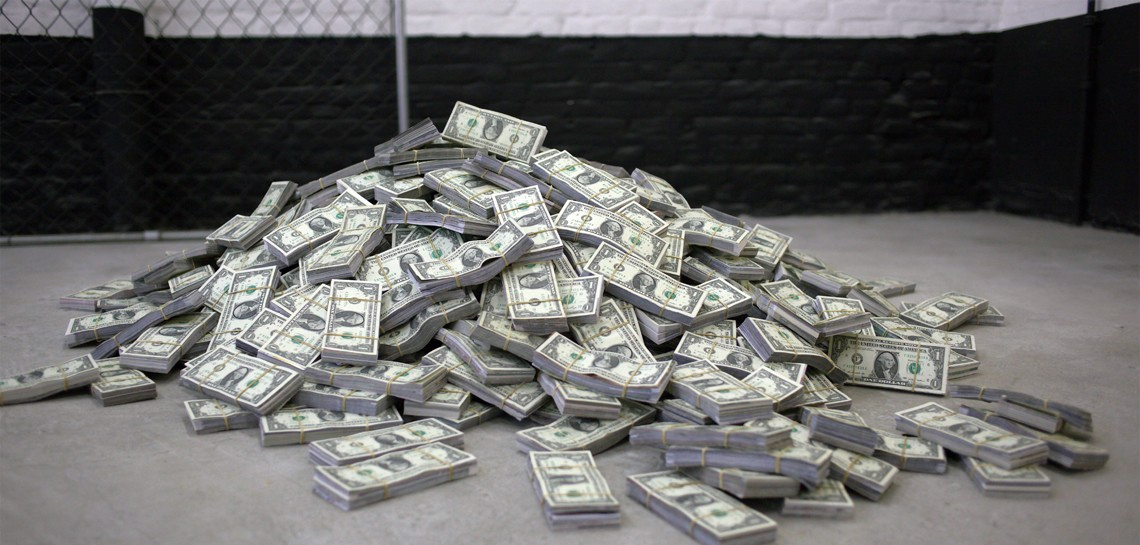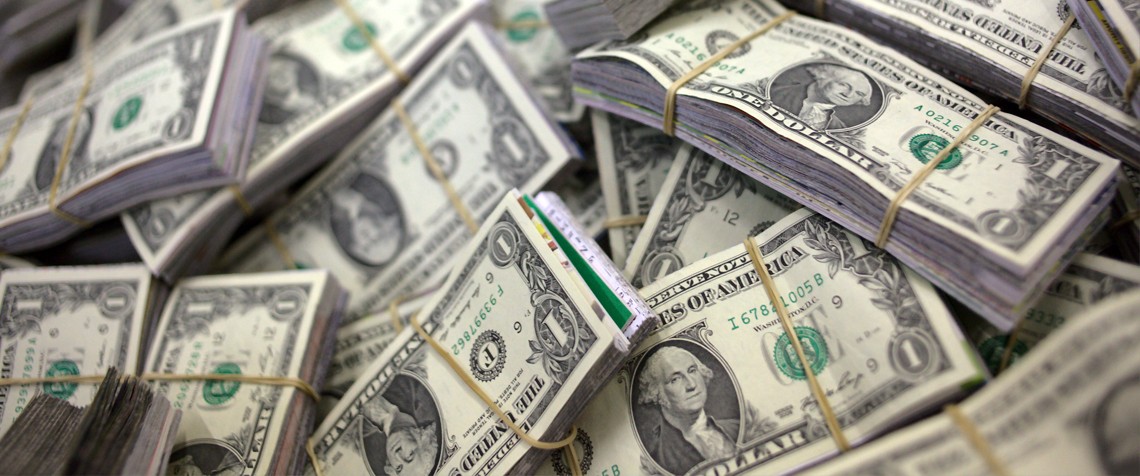The End of the Rainbow, 1$ bills, newspaper, recycled paper, 2011.
| “The major concern of the epoche – the economy – is to today’s art what the nude, the landscape, or the myth of the new were in their time to neoclassicism, impressionism, and the avant-garde: both a motivator of creativity and a theme to the taste of the moment”. Paul Ardenne |
Based on a series of incidents that took place in the early 1990’s in Romania, at the end of the Ceausescu regime, “The End of the Rainbow” examines the volatile nature of currency and the illusory quality of wealth, demonstrating just how unpredictable money and value can be. The stacks of false money are in fact a hyperbolic version of the ones that were once handed to Ioan Simonea, the artist’s grandfather. A self-made man, Ioan Simonea had worked hard all his life, accumulating a small yet sizeable fortune. Unfamiliar with capitalistic profit seeking money placement, he thought it best to keep his savings safely at home. In December 1989, as Romania awakened to new freedoms, privatization, and capitalist markets, he had saved enough Lei to buy himself a brand new house.The transition to capitalism held a few nasty surprises, however, bringing unforeseen ailments, such as devastating hyperinflation and uncontrolled devaluation. When Ioan Simonea saw his savings start to literally vanish into thin air (inflation rates began climbing to the hundreds in the early 1990’s, reaching 256% in 1993), he did what most people in his situation would do: to avoid further losses in the rapidly degenerating economy, the unreliable Lei (official Romanian currency) had to be converted in the black market. The American money seemed a sure way to get to the pot of gold at the end of the rainbow. Dollars for sale, cheaper, safer, more valuable dollars… Unfortunately, the “bisnitar”, unscrupulous money dealers, had already taken over the currency exchange markets. They did offer more than the official rate, but, taking advantage of the illegal nature of the transaction, they rushed the unsuspecting “customer” into their merciless scam. Operating very quickly, with the knack of street-fair magicians, they counted the real money while replacing it with the fake. Upon arriving at home, when he went to count his new money, Ioan Simonea discovered with shock that his life-long savings were forever gone, and with it, his dreams. In just a few minutes, the money had been irreparably transformed into worthless packs of paper, evenly cut newspaper, shrewdly camouflaged under a derisory amount of US dollars.
Is “The End of the Rainbow” some sort of memento to honor the victim of this infamous money scam? The story, in any case, offers a good lesson on the interconnectedness of money’s fluctuating value and the transiency of dreams. But what does this work have to say about art? Considered as visual art object, in other words at its most basic level, it could be approached as a schematic representation of today’s economic landscape, gathering, beneath the real dollars, a large variety of samples generated by the economic activity of our times: daily newspapers, real-estate brochures, fast-food advertising and other commercial flyers, free publications for urban commuters, discarded art-fair catalogues… The bulk of fake cash offers a compendium of our economy’s printed output, skillfully using the parts to represent the whole. If, on the other hand, we approach the work from a more conceptual perspective, some obvious parallels between art and money come to mind. For one, art, like money, is a symbol of economic value, and, as is the case with money, its economic value is a question of attribution, endorsement, and faith. Beyond these observations, however, which are only relevant to the art market, other more immaterial convergences of art and money come to light, suggesting that money, and its larger framework, the economy, have integrated the vocabulary of art: Duchamp’s “Tzanck Ckeque”, Beuy’s formula “Kunst=Kapital”, and Warhol’s statement “Making money is art” to mention but a few, and not the least, offer art-historical evidence of this fact. Without overstating the truth, it could be said that in today’s art world, money is measured in terms of both its economic value and its potential for generating sense.
Artists have been making art with money for a long time, which is not the same as making money with art. Whatever the combination, pairing the two never fails to raise some controversy, and occasionally some important considerations. Especially when the notion of work is associated to the equation, reviving the old question about the nature of the artist’s profession. Some might argue that if art is work and work earns money, then artists should get paid. In any case, the ideal for most artists would be to make a living with their work. Not all artists make money however, and they only get paid when they sell. Ciprian Homorodean overrides the question by combining the money and the work. This is also where the value of an artwork resides, in its intention. Once “The End of the Rainbow” is sold, the artist will have succeeded a most intricate exchange, making the money into art and back into money again.
The End of the Rainbow (detail), 1$ bills, newspaper, recycled paper, 2011.

